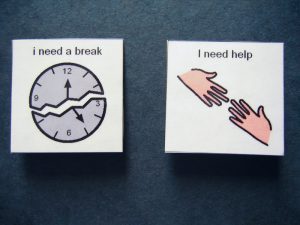Section 6: Practical Strategies across Settings
88 Help & Break Cards
 Individuals with autism spectrum disorder (ASD) may need a break or require help, but be unable to appropriately (i.e., without negative behavior) indicate that need to others. Functional communication skills and other alternative behaviors must be explicitly taught. By placing break/help cards within reach, gesturing to them as cues, and otherwise teaching their use, the likelihood of individuals indicating their needs with effective and functional communication may be increased. These cue cards should be placed in any area where individuals may be asked to complete demands (i.e., any area that is not a break or free play area).
Individuals with autism spectrum disorder (ASD) may need a break or require help, but be unable to appropriately (i.e., without negative behavior) indicate that need to others. Functional communication skills and other alternative behaviors must be explicitly taught. By placing break/help cards within reach, gesturing to them as cues, and otherwise teaching their use, the likelihood of individuals indicating their needs with effective and functional communication may be increased. These cue cards should be placed in any area where individuals may be asked to complete demands (i.e., any area that is not a break or free play area).
By making the cue cards accessible (they can also be stored on pulleys for further accessibility per below), it will be easier to gesture, cue, and/or prompt expectations when an individual appears confused, agitated, or overwhelmed. Specifically, the caregiver can point to the cards and prompt the individual to indicate his or her need without giving direct attention to any behavior that might be emerging. It is best to use these tools when the first signs of confusion or agitation are noted, not after behavior is at full scale.
